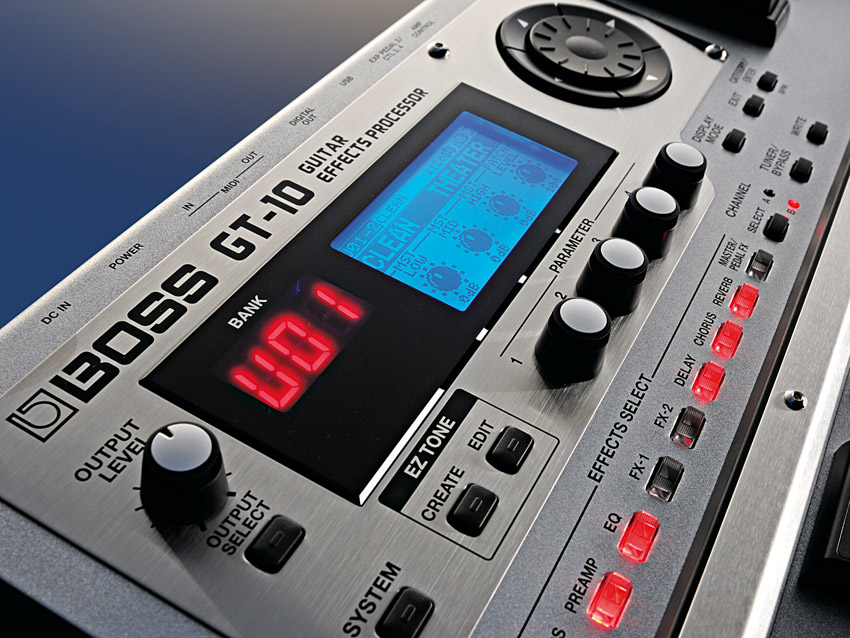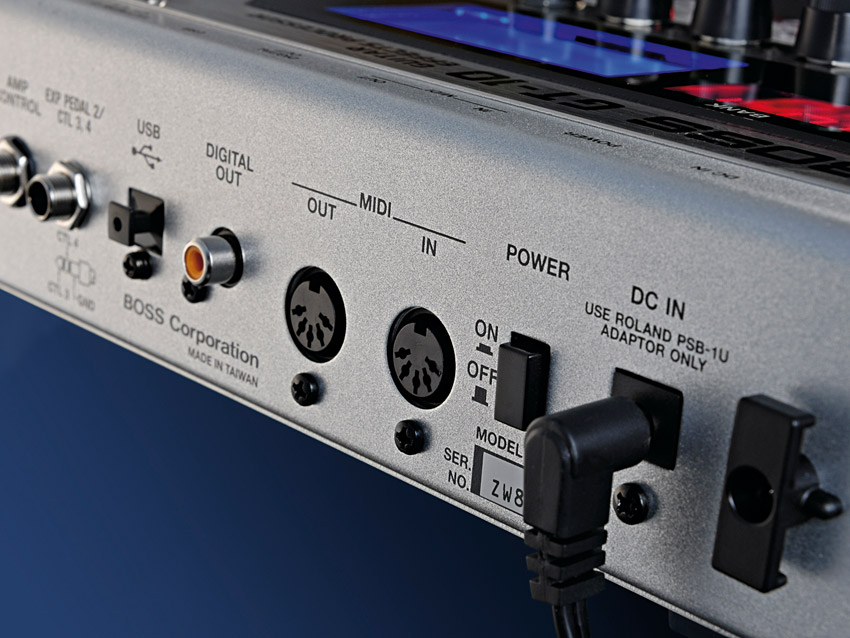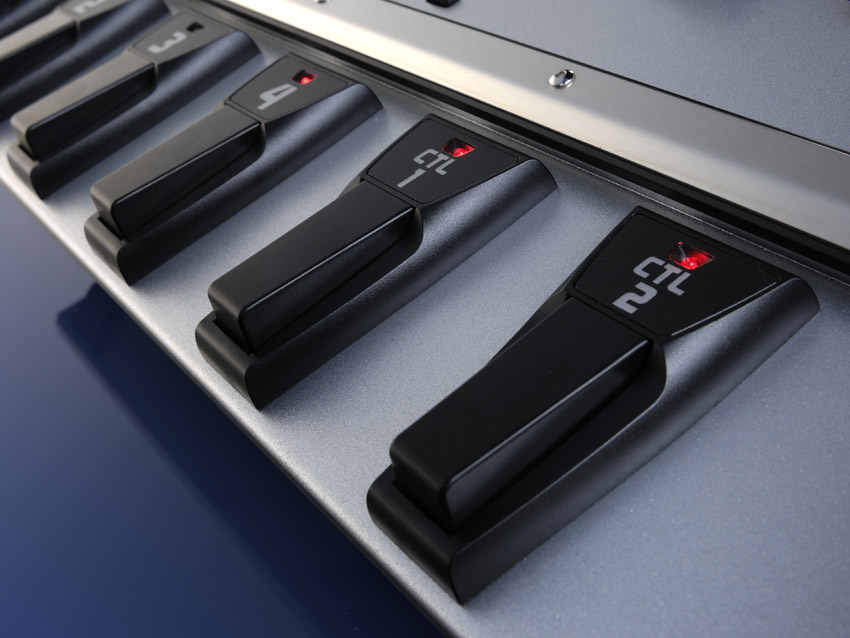MusicRadar Verdict
Not all multi-FX are equal. The GT-10 treads the fine line between features and durability, and it delivers.
Pros
- +
Fantastic sound quality. User-friendly looper.
Cons
- -
Not much scope for movement on the expression pedal.
MusicRadar's got your back

Boss GT-10

Boss GT-10

Boss GT-10
The Boss GT series has played a major part in the evolution of floorboard multi-effects units since the mid-nineties.
One of the criticisms of the last GT unit, the GT-8, was the sheer complexity of the user interface compared to the 'amp-style' layouts used by Line 6 and others. While it could arguably be described as being more amp-like in terms of the unparalleled amount of real-time control, the number of knobs and pushbuttons on the GT-8 made it quite tricky to navigate in a hurry.
This is the perennial problem with multi-effects units: how much control should you have instant access to, and how much should be hidden in menus? With the GT-10, Boss has dialled back a great deal of the real-time control. However, as we'll see, this certainly doesn't mean we're jumping back to the bad old days of the nineties where nested menus ruled the roost.
Construction is very solid, with the whole unit housed in a steel casing. The expression pedal is made of the same material, leaving only the raised plastic knobs and footswitches as possible onstage damage risks.
"There's plenty of rich detail to the amp sounds, and the reverb and delay effects are crisp and well defined."
A raised metal 'kerb' separates the main row of footswitches from the rest of the control panel. This is a really good idea as there isn't much space between the hand controls and footswitches, so it stops your boots from inadvertently hitting the patch editing buttons.
Control
In use, the GT-10's patches are arranged in banks of four; there are 200 factory presets and 200 user memory slots. Navigation involves the bank up/down footswitches and the first four of the main row of footswitches. The other two switches on the main row are used for 'Control' functions, that vary according to the current patch.
On most of the presets, the first switch selects the preamp channels, while the other toggles an effect on and off.
For on-the-fly adjustment, the control panel features a main output level control and four more knobs that alter the four parameters (again patch-dependent and user-assignable) shown at the bottom of the large, bright display. A row of pushbuttons enables you to add or remove a particular effects module from the patch quickly.
Things get a little complex when you start exploring the intimate workings of the GT-10, but don't panic just yet. The EZ-Tone feature offers an easier way of accessing the operating system, with a clear graphical interface.
Having entered your pickup type and output set-up, you can then choose tones from a range of genre-specific groups. The power of the GT-10's large display becomes obvious in the next step, where overdrive/distortion characteristics and effect settings are controlled. This is done by X-Y co-ordinates on screen, rather than with lists of numbers.
"Should you choose to delve a little deeper, you'll find a mind-boggling level of flexibility in the GT-10's signal chain."
It sounds complicated, but it's really very easy to use. For example, when setting overdrive, moving the cursor left or right adjusts the soft/hard nature of the overdrive, while moving it up or down fine-tunes its suitability for rhythm or lead use.
It's very intuitive and enables you to concentrate on the overall sound, rather than adjusting parameters in isolation. Alternatively, you can use the EZ-Tone Edit button for quick access to four useful parameters in the current patch.
Should you choose to delve a little deeper, you'll find a mind-boggling level of flexibility in the GT-10's signal chain. There are 10 modules and all can be used simultaneously.
As we mentioned, the preamp models have twin channels, and these can be used in a variety of ways: one at a time, mixed, panned in stereo or dynamically switching according to your picking dynamics. Apart from the preamp channels, all the effects modules can be moved within the chain.
Sounds
Hear Guitarist's Dave Durban demonstrate a range of the GT-10's sounds:
In keeping with the polished, assured feel of the overall design, the GT-10 sounds great. Even with the standard line-level outputs, the 24-bit processing of the dual COSM modelling engines is apparent. There's plenty of rich detail to the amp sounds, and the reverb and delay effects are crisp and well defined.
As we've mentioned before, many modelling/effects units have now reached such a level of sophistication that they can't be judged on simple functionality. They all make great sounds that do a pretty convincing job of sounding something like real amps.
The difference now is largely down to personal taste and which unit does the best job of satisfying your personal concept of what constitutes a Marshall sound, for example.
Although the DigiTech RP500 is a good bit cheaper than the GT-10, it also boasts the latest version of a proprietary modelling technology. Comparing the two units side by side, the GT-10 has a brighter overall sound that is more apparent on overdriven patches.
If anything, this works slightly better on the metal tones which seem to have a tighter mid-range response. For cleaner sounds and modulation effects there isn't much in it, although we were particularly impressed with the richness of the GT-10's plate reverb sounds. All this proves is that there's no 'perfect' model of a famous amp sound; you have to decide which one works for you.
Although the generally professional feel of the GT-10 means that you won't find a drum machine or input for your MP3 player, one particularly nice feature is the Phrase Loop.
This loop sampler is controlled via the bank up/down footswitches and offers up to 38 seconds recording time in mono; stereo operation halves this. It's quite rudimentary, so there's no facility to undo your last overdub, for example, but it's great for experimenting with layered guitar textures and practising your improvisation skills. What's more, the sound quality is excellent.
You can probably tell that we're impressed with the GT-10, but then we expected to be; the GT range has been dependably classy for over 10 years. It's good to see that the complex interface of the GT-8 has been stripped down and simplified for the new model, and the result is very user-friendly, despite the system's flexibility.
It might be considerably more expensive than a lot of pedalboard units on the market, but we think it's a fair price. This isn't a budget-priced unit for bedroom jamming, but it's a great tool for a professional gigging or recording guitarist.
“These tariff actions will have a long-term effect on musicians worldwide”: The CEO of NAMM urges Trump to dump tariffs on components of musical instruments
Brace yourself: Bryan Adams didn’t buy his first real six-string in a five and dime
“Nobody listens to one genre. I literally don’t know anybody who listens to one genre. You can be a fan of so many different artists at once”: Laufey on what Gen Z can teach the rest of us about how to appreciate music









